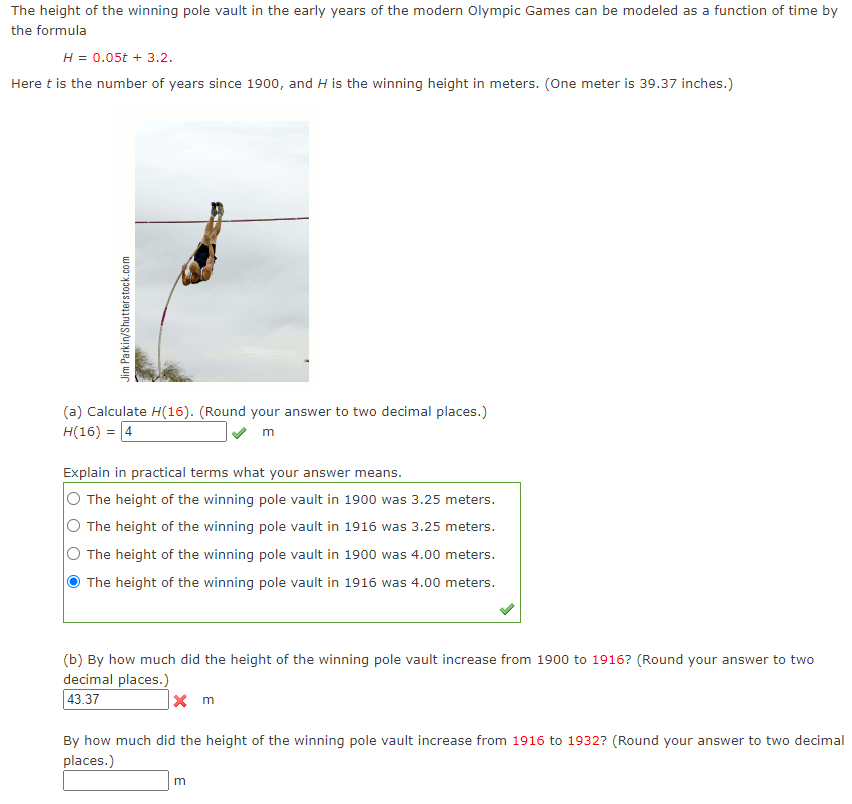the formula ng pore Jim Parkin/Shutterstock.com H = 0.05t + 3.2. Here t is the number of years since 1900, and H is the winning height in meters. (One meter is 39.37 inches.) (a) Calculate H(16). (Round your answer to two decimal places.) H(16) = 4 m Explain in practical terms what your answer means. O The height of the winning pole vault in 1900 was 3.25 meters. O The height of the winning pole vault in 1916 was 3.25 meters. O The height of the winning pole vault in 1900 was 4.00 meters. The height of the winning pole vault in 1916 was 4.00 meters. as d (b) By how much did the height of the winning pole vault increase from 1900 to 1916? (Round your answer to two decimal places.) 43.37 x m By how much did the height of the winning pole vault increase from 1916 to 1932? (Round your answer to two decimal places.) m
the formula ng pore Jim Parkin/Shutterstock.com H = 0.05t + 3.2. Here t is the number of years since 1900, and H is the winning height in meters. (One meter is 39.37 inches.) (a) Calculate H(16). (Round your answer to two decimal places.) H(16) = 4 m Explain in practical terms what your answer means. O The height of the winning pole vault in 1900 was 3.25 meters. O The height of the winning pole vault in 1916 was 3.25 meters. O The height of the winning pole vault in 1900 was 4.00 meters. The height of the winning pole vault in 1916 was 4.00 meters. as d (b) By how much did the height of the winning pole vault increase from 1900 to 1916? (Round your answer to two decimal places.) 43.37 x m By how much did the height of the winning pole vault increase from 1916 to 1932? (Round your answer to two decimal places.) m
Glencoe Algebra 1, Student Edition, 9780079039897, 0079039898, 2018
18th Edition
ISBN:9780079039897
Author:Carter
Publisher:Carter
Chapter8: Polynomials
Section8.1: Adding And Subtracting Polynomials
Problem 44PPS
Related questions
Question

Transcribed Image Text:The height of the winning pole vault in the early years of the modern Olympic Games can be modeled as a function of time by
the formula
H = 0.05t + 3.2.
Here t is the number of years since 1900, and H is the winning height in meters. (One meter is 39.37 inches.)
Jim Parkin/Shutterstock.com
(a) Calculate H(16). (Round your answer to two decimal places.)
= 4
H(16)
m
Explain in practical terms what your answer means.
The height of the winning pole vault in 1900 was 3.25 meters.
The height of the winning pole vault in 1916 was 3.25 meters.
The height of the winning pole vault in 1900 was 4.00 meters.
The height of the winning pole vault in 1916 was 4.00 meters.
(b) By how much did the height of the winning pole vault increase from 1900 to 1916? (Round your answer to two
decimal places.)
43.37
Xm
By how much did the height of the winning pole vault increase from 1916 to 1932? (Round your answer to two decimal
places.)
m
Expert Solution
This question has been solved!
Explore an expertly crafted, step-by-step solution for a thorough understanding of key concepts.
Step by step
Solved in 2 steps with 1 images

Recommended textbooks for you

Glencoe Algebra 1, Student Edition, 9780079039897…
Algebra
ISBN:
9780079039897
Author:
Carter
Publisher:
McGraw Hill

Trigonometry (MindTap Course List)
Trigonometry
ISBN:
9781337278461
Author:
Ron Larson
Publisher:
Cengage Learning


Glencoe Algebra 1, Student Edition, 9780079039897…
Algebra
ISBN:
9780079039897
Author:
Carter
Publisher:
McGraw Hill

Trigonometry (MindTap Course List)
Trigonometry
ISBN:
9781337278461
Author:
Ron Larson
Publisher:
Cengage Learning


Intermediate Algebra
Algebra
ISBN:
9781285195728
Author:
Jerome E. Kaufmann, Karen L. Schwitters
Publisher:
Cengage Learning


College Algebra (MindTap Course List)
Algebra
ISBN:
9781305652231
Author:
R. David Gustafson, Jeff Hughes
Publisher:
Cengage Learning